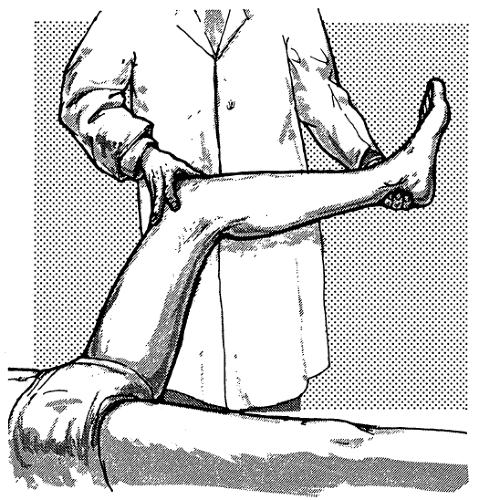Miscellaneous Neurologic Signs
Miscellaneous neurologic signs—some of them reflexes, some closely related to the defense and postural reflex mechanisms, and others more varied in nature—are elicited in certain diseases of the nervous system.
SIGNS OF MENINGEAL IRRITATION
Meningeal signs are elicited most frequently when the meninges are inflamed—from infection (e.g., bacterial meningitis) or from the presence of a foreign material (e.g., blood in the subarachnoid space). Meningismus is a term that refers to the presence of nuchal rigidity and other clinical signs of meningeal inflammation. Meningism is sometimes used synonymously with meningismus, but it is also used to refer to a syndrome characterized by neck stiffness without meningeal inflammation, seen in patients with systemic infections, particularly young children.
The clinical manifestations of meningeal irritation are varied and depend on the severity of the process. Accompaniments depend on etiology but commonly include headache, pain and stiffness of the neck; irritability; photophobia; nausea and vomiting; and other manifestations of infection, such as fever and chills. The various maneuvers used to elicit meningeal signs produce tension on inflamed and hypersensitive spinal nerve roots, and the resulting signs are postures, protective muscle contractions, or other movements that minimize the stretch and distortion of the meninges and roots.
Nuchal (Cervical) Rigidity
Nuchal rigidity is the most widely recognized and frequently encountered sign of meningeal irritation, and the diagnosis of meningitis is rarely made in its absence. It is characterized by stiffness and spasm of the neck muscles, with pain on attempted voluntary movement as well as resistance to passive movement. The degree of rigidity varies. There may be only slight resistance to passive flexion, or marked spasm of all the neck muscles. Nuchal rigidity primarily affects the extensor muscles, and the most prominent early finding in meningeal irritation is resistance to passive neck flexion. The physician is unable to place the patient’s chin on his chest, but the neck can be hyperextended without difficulty; rotatory and lateral movements may also be preserved. With more severe nuchal rigidity there may be resistance to extension and rotatory movements as well. Extreme rigidity causes retraction of the neck into a position of opisthotonos, the body assuming a wrestler’s bridge or arc de cercle position, with the head thrust back and the trunk arched forward. Rigidity may be absent in meningitis when the disease is fulminating or terminal, when the patient is in coma, or in infants.
Stiffness and rigidity of the neck may occur in other conditions. A common problem is to distinguish restricted neck motion due to cervical spondylosis or osteoarthritis from nuchal rigidity. Patients with osteoarthritis typically have difficulty with rotation and lateral bending of the neck; these motions are usually preserved in patients who have meningismus, unless the meningeal irritation is extremely severe. Restricted neck motion may also occur with retropharyngeal abscess, cervical lymphadenopathy, neck trauma, and as a nonspecific manifestation in severe systemic infections. Extrapyramidal disorders, particularly progressive supranuclear palsy, may also cause diffuse rigidity of the neck muscles. Meningeal signs may occur with increased spinal fluid pressure, and nuchal rigidity may be a manifestation of cerebellar tonsillar (foramen magnum) herniation. Meningeal irritation may also cause resistance to movement of the legs and back, with the patient lying with his legs drawn up and resisting passive extension.
Kernig Sign
There is some variability in the descriptions of how to elicit a Kernig sign. Kernig described an involuntary flexion at the knee when the examiner attempted to flex the hip with the knee extended. The more common method is to flex the hip and knee to right angles, and then attempt to passively extend the knee. This movement produces pain, resistance, and inability to fully extend the knee; another definition of Kernig sign is inability to extend the knee to over 135 degrees while the hip is flexed (Figure 36.1). There is some overlap between Kernig sign and the Lasègue (straight leg raising) sign. The technique is similar, but Lasègue sign is used to check for root irritation in lumbosacral radiculopathy. Both Kernig sign and straight leg raising are positive in meningitis because of diffuse inflammation of the nerve roots and meninges, and positive with acute lumbosacral radiculopathy because of focal inflammation of the affected root. In radiculopathy the signs are usually unilateral, but in meningitis they are bilateral.
Brudzinski Neck Sign
Placing one hand under the patient’s head and flexing the neck while holding down the chest with the other hand causes flexion of the hips and knees bilaterally. With severe meningismus, it may not be possible to hold the chest down, and the patient may be pulled into a sitting position with only the examiner’s hand behind the head. Occasionally there may be extension of the hallux and fanning of the toes, and sometimes arm flexion. The leg may fail to flex on one side when meningeal irritation and hemiplegia coexist.
Other Meningeal Signs
To avoid spinal flexion, the patient with meningitis may sit in bed with the hands placed far behind, the head thrown back, the hips and knees flexed, and the back arched (Amoss, Hoyne, or tripod sign).
SIGNS OF TETANY
The clinical manifestations of tetany include spasm and tonic contractions of the skeletal muscles, principally the distal muscles of the extremities. There may be carpopedal spasm, with tonic contraction of the muscles of the wrists, hands, fingers, feet, and toes. There is hyperexcitability of the entire peripheral nervous system, as well as the musculature, to even minimal stimuli. Sensory nerve involvement may cause paresthesias in the hands, feet, and perioral region. Tetany is related to a disturbance of calcium metabolism or alkalosis, causing a decrease in the ionized calcium level. Certain neurologic signs may be present that aid in making a diagnosis on the basis of the clinical examination alone. They are more easily obtained if the patient first hyperventilates for a few minutes (latent tetany). Severe tetany may cause seizures, laryngospasm, stridor, and respiratory arrest.
Stay updated, free articles. Join our Telegram channel

Full access? Get Clinical Tree









